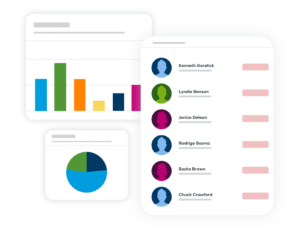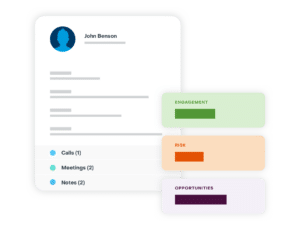7 Steps to Meet the Customer Experience Imperative
Customers will leave after a bad experience with your company, meaning customer experience (CX) is the difference between red and black in your business ledger. If you can’t differentiate by consistently delivering an exceptional and effortless experience, your customers will move on to your competition.
Our study, based on a survey of 1,600 global sales and marketing professionals worldwide, underscores the impact of CX on customer churn. With customers leaving in droves—32% globally and 47% in the U.S.—it’s no surprise that CX is a top business priority as continued growth hinges on getting it right.
This article provides seven steps businesses can take to help meet the CX imperative and cultivate customers for life, resolving the Great Customer Resignation.
Step 1: Identify Why Customers Leave Your Business
Last year, our global survey revealed customer churn was costing mid-market companies an average of $5.5M per year.
In this year’s survey, 58% of respondents said their customer churn rate has increased over the last 12 months.
The scary truth is most companies don’t even know they’ve lost a customer until well after they have moved on to the open arms of a competitor. Overcoming customer flight starts with knowing when customers are at risk of churn. Yet, more than half acknowledge that they cannot track, quantify, or prevent churn—and don’t understand why customers are leaving their ranks in the first place.
Every customer interaction is a decisive moment for identifying the gaps between customer expectations and what they actually experience. Implementing CX processes and data collection to close this gap is critical to understanding the potential for churn and taking the right steps to improve retention.

Step 2: Use CX Shortfalls to Guide Corrective Actions
Customer flight is a symptom of an organization’s inability to provide a compelling, consistent, and personalized CX across all customer touchpoints and throughout the customer lifecycle.
Some 80% of sales and marketing leaders believe their customers leave due to a lack of communication and personalized, relevant messaging.
In reality, experiences can fall short of expectations in many ways, including disconnected communications, poor messaging, frustrating service experiences, and a general lack of trust in brands.
Knowledge is power. The more information you know about your customers, the easier it is to create a high-definition and personalized CX across sales, marketing, and service.
Resilient organizations will insist on ensuring organizational awareness of where they are falling short and acknowledging current process deficiencies that persist so that they can take the necessary corrective actions.
Step 3: Understand the Paramount Importance of Better Data Visibility
A primary challenge for many organizations is having an incomplete view of customer activity.
Three-quarters of respondents (75%) in our survey say a unified view of sales, marketing, and service is critical to delivering an optimal CX. However, the lack of such a data infrastructure is fueling a customer relationship crisis.
Organizations might have the required information but cannot effectively share it across teams. A shared customer relationship management (CRM) data platform and business intelligence system fuels the actionable insights that sales, marketing, and service teams need to act decisively at every critical touchpoint throughout the customer journey.

Step 4: Make Technology Easier to Use
Technology is supposed to make the hard things easier, but our data suggests it is often too difficult to use, resulting in low adoption and wasted resources.
An overwhelming majority of sales and marketing professionals (76% of those surveyed) say their biggest frustration with traditional CRM solutions is their complexity.
Usability is a critical issue, especially in times when many rely even more on technology to get their daily work done.
CRM must be more accessible, meaning it should be easy to use daily and easy to update, expand, and capture and share customer information. Advanced CRM platforms serve up AI-driven insights, providing a better context for teams to take action earlier—with appropriate next steps, knowing what opportunities to pursue, and personalizing interactions to optimize experiences and grow revenue. Additionally, today’s CRM offers low-code, no-code capabilities designed to put change in the hands of non-technical business users.
Step 5: Level Up Your CX Game with More Quality Sales and Lead Generation
Driving high quality marketing leads into the sales pipeline is critical to business success. Still, generating qualified leads remains an elusive task for many organizations.
Our study reveals that more than half (54%) of marketing sales leads are deemed poorly qualified or underqualified, resulting in wasted efforts and lost opportunities.
By providing sellers with complete lead information, sharing the history of their customer journey, tracking conversion rates, and sharing customer preference insights, customer engagement teams can synchronize their strategy for generating and acting on the most valuable leads.
And while most sales and marketing leaders know it’s easier to keep an existing customer than find a new one, retaining that customer can be challenging when the experience just doesn’t match expectations.
Step 6: Acknowledge That Delivering Superior CX is Everyone’s Job
CX must be ingrained into the company culture so that it’s everyone’s overriding focus, transcending departmental silos. The entire organization must work together to create customers for life. An integrated approach is vital, aligning teams and insights under one technology roof.
When 63% of sales and marketing leaders agree that misalignment across customer-facing teams prevents their organization from growing its business, it’s time to act decisively to break down workplace data silos.
Good organizational alignment is driven by several critical factors, including seeing and utilizing relevant data, establishing mutual goals and metrics, and creating a seamless handoff process to improve productivity and ensure ownership. An integrated CRM platform ensures that the left hand knows what the right hand is doing, and the process starts before prospects enter the pipeline.

Step 7: Leverage Artificial Intelligence to Help Move the CX Dial
Innovations in artificial intelligence (AI) are advancing organizations to shift their focus. They no longer look in the data rearview mirror; instead, they are becoming forward-looking to spot actionable insights earlier. Not surprisingly, sales and marketing AI use cases have seen some of the highest adoption rates, as they can directly impact revenue. And with more data available—especially from digital channels—AI can enable better customer experiences, more personalized engagement, more accurate predictions, and better decision-making.
AI and CRM are a natural pairing; deploying AI takes advantage of your existing CRM data by transforming it into useful information that improves decision-making and predicts customer needs.
While nine in ten companies use AI today, the question is whether they can derive real value from its usage and how many processes can be improved. Use cases for AI solutions with high adoption include:
- Automated emails (44%)
- Account intelligence (40%)
- Conversational AI (36%)
- Lead conversion (33%)
- Opportunity close prediction (33%)
The Time to Improve Customer Retention is Now
The hard things are now easier in the age of modern CRM platforms powered by AI, enhancing operational efficiency and providing the actionable insights crucial for businesses to drive engagement and deliver experiences that keep customers coming back for more.
When you follow these seven steps, you are empowering the organization to anticipate and meet your customer’s needs. The result of these efforts is the ability to provide exceptional customer experiences and the opportunity to transcend the Great Customer Resignation to create customers for life.
This blog article was initially published in Martech Zone.



